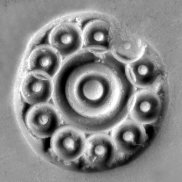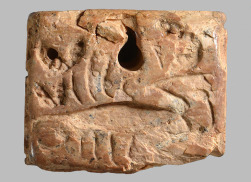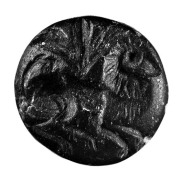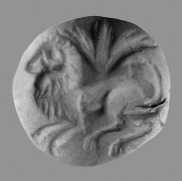New finds - Older
2019
The Seals from the Minoan Site of Chryssi Island: Local, Regional, and Global Implications
By Sydney Sarasin
Abstract (from the book): Five seals come from a Minoan site on the island of Chryssi, just off the southeastern coast of Crete. Four of these seals are sealstones, and one is the bezel of a metal seal ring. These seals are important as individual objects to allow for a deeper understanding of the people that inhabited Chryssi Island during the Bronze Age, but a further understanding of the site itself is also garnered by expanding the focus to include all of the seals of Crete. By doing so, this study allows for the discussion of regional interactions among the people of Chryssi and various other Minoan sites throughout Crete. The various approaches to seals come together to suggest the same conclusions, most notably that at least some of the people on Chryssi enjoyed a life of limited luxury through the control of various industries on the island, particularly the production of murex purple dye.
2018
An agate amygdaloid with a battle scene from the Griffin Warrior Tomb freshly published in The New York Times and the UC Magazine! Unparalleled!
2016
During the 2015 excavation campaign of the Univerity of Cincinnati at Pylos, lead by Jack Davis and Sharon Stocker, an unplundered tomb of a very rich and probably very powerful Mycenaean man was found. The tomb was named by its excavators Griffin Warrior Tomb and contained more than 2000 objects. Among the artifacts recovered from the tomb were more than 50 sealstones and four impressive golden signet rings!
For more on this subject see:
- Griffin Warrior Tomb Official Website with a list of web publications on the topic.
- N. Wade, Grave of 'Griffin Warrior' at Pylos Could be a Gateway to Civilisations, The New York Times 26 Oct. 2015 (2015).
For impressive photographs of some of the seals, see also:
2014
The 2013 excavation campaign of Minoan Koumasa in the fertile plain of the Mesara has brought to light unexpected and impressive finds. The excavation, which started in 2012 and is directed by Diamantis Panagiotopoulos (University of Heidelberg), takes place in the area of the Minoan settlement, the so-called sanctuary, and the tholoi. Minoan Koumasa had first been investigated by Stefanos Xanthoudides at the start of the 20th century. Xanthoudides had concentrated mainly in the excavation of the tholoi and for this reason, these were not expected to produce any more finds. In the excavation campaign of 2013, however, the tombs produced an impressive amount of finds, among which were also 17 seals of the pre- and protopalatial period!
For the excavations of Xanthoudides in the Mesara, see
2013
May
In the excavations carried out in Petras, Crete from 2005 to 2011 twenty seals came to light. The seals, discovered in the cemetery and dated from the prepalatial to the protopalatial period, are a welcomed addition to the corpus of Minoan seals for two reasons. First, the prepalatial seals belong to groups of seals that have scarcely been found in contexts to the east of Mochlos. And secondly, the majority of the protopalatial seals are hard stone prisms of the Hieroglyphic Deposit Group, a group whose representatives have not been known up to now from protopalatial excavated contexts! The protopalatial seals have been recovered from house tombs, which the excavator Metaxia Tsipopoulou has suggested must have been associated with elite members of the Petras society.
Interestingly, no seals were recovered from the area of the settlement during the campaigns 2005-2011. However, an archive containing documents of the hieroglyphic script and among them, sealings with seal impressions has been discovered from the Petras palace. Unfortunately, the seal impressions are only fragmentarily preserved and their motifs are often difficult to discern. Despite that, Metaxia Tsipopoulou and Erik Hallager who have published the finds from the archive have suggested that four of the impressions were impressed by seals bearing hieroglyphic inscriptions and thus most probably belonging to the Hieroglyphic Deposit Group!
For more information, see
Krzyszkowska, O., 2012. ‘Seals from the Petras cemetery: a preliminary overview’ in M. Tsipopoulou, Petras, Siteia 25 Years of Excavations and Studies. Monographs of the Danish Institute at Athens 16. Athens, 145-160.
Tsipopoulou, M., and Hallager, E., 2010. The Hieroglyphic Archive at Petras, Siteia. Monographs of the Danish Institute at Athens 9. Athens.
April
In the last years of the excavation campaign in Sissi, Crete, seven seals came to light! The earliest is a soft-stone Petshaft from the cemetery dating to MM II and the latest are lentoids dating to LM I. Of particular interest is the fact that most LM I pieces were recovered in LM III contexts. This suggests that they were heirlooms or chance finds in LM III. One wonders why LM III seals have not yet been found in the site!
For more information, see
Anastasiadou, M., 2011.‘4. Seal 10-05-1882-OB001’ ‘1.7. The seal’, in J. Driessen et al., Excavations at Sissi II. Preliminary Report on the 2009-2010 Campaigns. Louvain-la-Neuve, 160-161, 171-172.
- 2012. ‘5. A sealstone from compartment 9.4’, '6. A note on the seals', '3. A note on the seals', in J. Driessen et al., Excavations at Sissi III. Preliminary Report on the 2011 Campaign. Louvain-la-Neuve, 50-51, 76-77, 113-115.
February
An unexpected find!
A MM II four sided prism with hieroglyphic inscriptions on all its sides was found in western Crete! This is not only the first hieroglyphic inscription but also the first seal of this type from western Crete! The piece, cut in steatite, was found in the Minoan peak sanctuary of Vrysinas in 2011.
For more information, see
Hallager, E., - Papadopoulou, E., - Tzachili, I., 2011. 'VRY S (4/4) 01 - The first hieroglyphic inscription from western Crete', Kadmos 50, 63-74.





